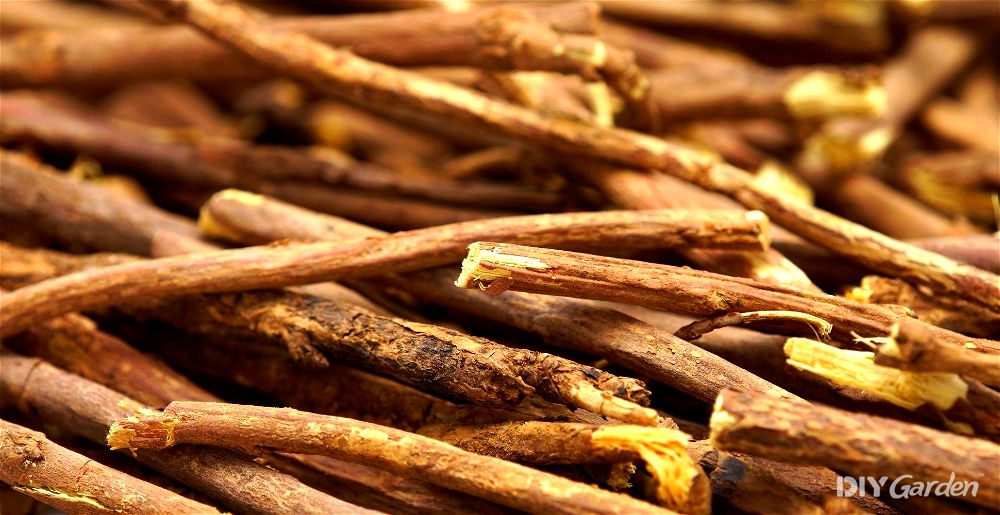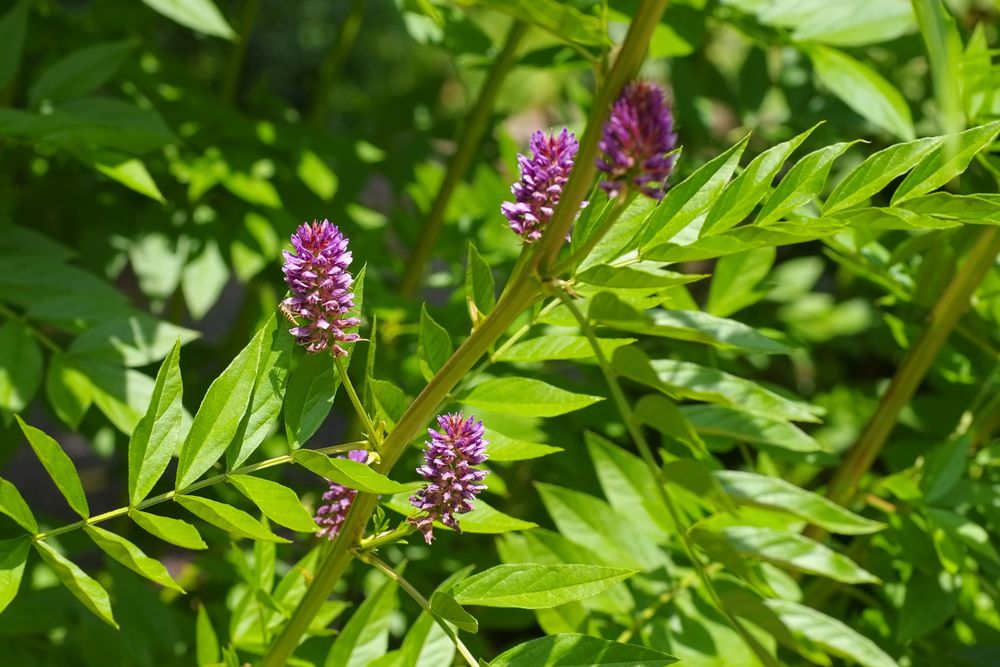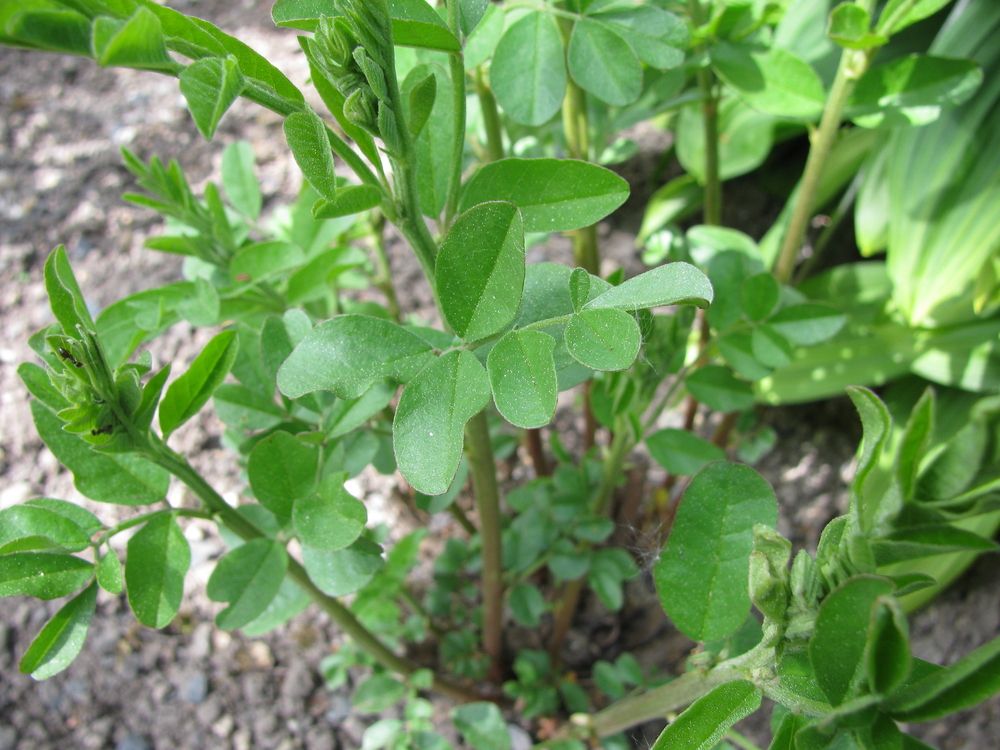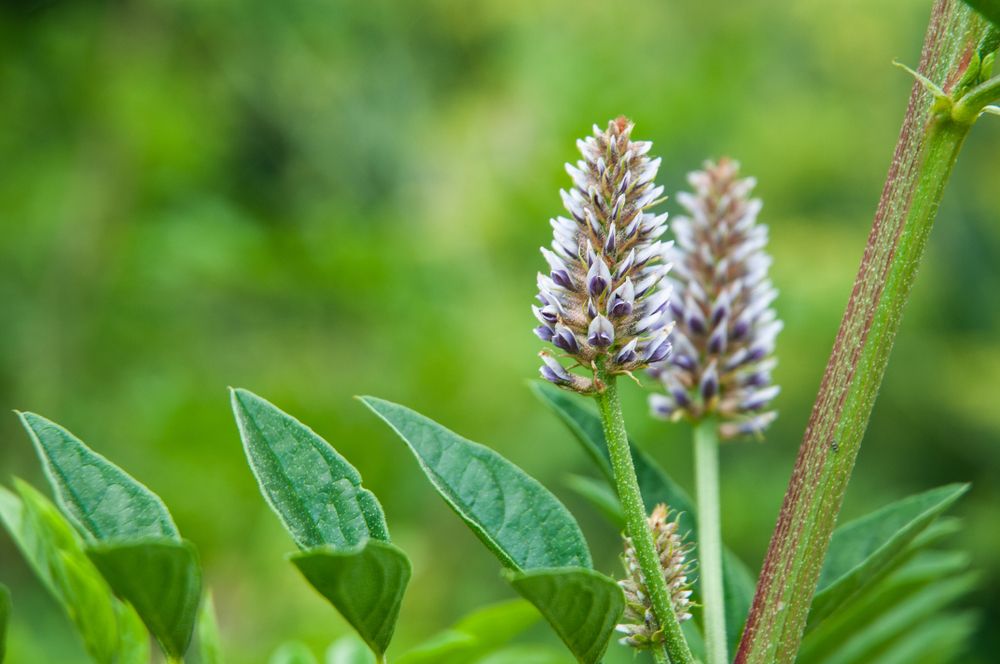
People usually either love or hate the sugary sweet, anise-like flavour of liquorice. However, whichever side of the divide you stand, this deciduous perennial is one that’s still worth growing. You don’t need to harvest its edible roots to appreciate its fern-like foliage, attractive violet flowers, and impressive size, all of which give this plant stunning ornamental qualities too.
Growing Liquorice: A Quick Snapshot
When to Sow – Mar-May/Sep-Oct
When to Plant – Apr-Jul
When to Harvest – Sep-Nov
Average Yield per Plant – 60g/year
Spacing – 90-150cm
Depth – 0cm
How to Grow Liquorice at Home
Liquorice root (Glycyrrhiza glabra) has been grown for centuries, not only as a culinary ingredient but also for its medicinal properties. Research shows that it has the potential to help with everything from indigestion and ulcers to respiratory conditions and certain cancers.
Whether you’re into herbal remedies or you simply enjoy the flavour of liquorice and would like to grow your own healthier version of this sweet treat, liquorice is a plant that’s easy to cultivate, so long as you give it the right conditions.
Growing Requirements for Liquorice Plants
Although native to parts of Asia and south-east Europe, liquorice was brought into western Europe, and other colder regions around the world, in the 12th century, and has been happily growing in a variety of climates ever since.
Its foliage dies back in the autumn, allowing some varieties to tolerate winter temperatures down to -15°C, or even colder if you provide a little protection. That said, liquorice plants do love the heat. The more warmth you give them, the sweeter those roots will taste.
Liquorice plants enjoy the sun, but will grow well in partial shade too. However, keep them too shaded and they’ll end up leggy with poor root quality.
It surprises many to learn that liquorice is a member of the pea family. This means, just like peas, they’ll do well in all soil types (apart from clay), so long as their soil is well-draining. It’s worth noting that in its native environment, wild liquorice plants thrive on sandy riverbanks.
In terms of space, you’ll need plenty of it to grow liquorice. The plants turn into large bushes, with some varieties ending up around 1.5m tall and wide once mature, which takes about 4-5 years.
How to Grow Liquorice from Seed
Liquorice seeds should either be sown a few weeks before your last spring frost date, or in the autumn/early winter. If you do the latter, you’ll need to keep your plants protected over the winter, since you’ll only be able to plant them outside once you’ve had your last spring frost.
Although liquorice seeds can be direct sown outside, results are much better when you start the seeds indoors in pots. However, this means that you’ll need to cold stratify your seeds first – they need cold temperatures that mimic the conditions of winter to break down their tough outer coating.
How to Cold Stratify Liquorice Seeds:
- Soak your liquorice seeds in room temperature water for about two hours
- Place your seeds onto one half of a damp paper towel
- Fold the paper towel over so that the seeds are sandwiched in between
- Put this into a zip-lock bag and then place the bag in your fridge
- Regularly check on your seeds to ensure that the paper towel remains damp. If it starts to dry out, mist it with water
- After 3-4 weeks, remove the bag from your fridge and immediately sow the seeds
How to Sow Liquorice Seeds:
- Fill small pots with a 60/40 mix of multi-purpose compost and perlite. Alternatively, mix some sand or fine grit into your multi-purpose compost to increase drainage
- Water your compost mix, making sure that excess water is able to drain out of the holes underneath your pots
- Lightly press your seeds onto the surface of the compost – liquorice seeds need light to germinate, so don’t cover them over. Since germination can be quite erratic, sow 4-5 seeds per pot, and sow more pots than you need
- Place your pots somewhere warm. A heated propagator would be ideal, as germination is best when liquorice seeds are given consistent temperatures of around 20°C
Keep the pots moist and your liquorice seeds should germinate in 2-3 weeks. Give them a week or so to grow before thinning them out, so that you have just one healthy seedling growing in each pot.
How to Plant Liquorice Outside
Young liquorice plants can be very delicate, so make sure that you’ve had your last spring frost before planting your liquorice outside. Your plants should also be around 7-10cm in height, with at least one set of true leaves, before you move them on.
To help your plants acclimatise to the harsh elements outside, harden them off for a week or so.
Then, make sure that your growing area is weed-free before digging holes that are a few centimetres wider and deeper than the size of the pots that your plants are currently in. Space each hole about 90-150cm apart, depending on the variety that you’re growing. The more space that each plant has, the larger its root system will grow.
Remove your plants from their pots and place them into their new homes, before backfilling the hole with soil. Firm the soil down around each plant and then give your plants plenty of water.
How to Plant Liquorice in a Greenhouse
Due to how large liquorice plants can get during the summer months, they’re very rarely grown in a greenhouse.
However, for those of you in colder climates, a greenhouse can be useful for overwintering liquorice plants. However, this means that you’d have to grow your liquorice in containers, which can be a little tricky.
Due to their very long and extensive root system, liquorice plants need depth – think dustbin rather than plant pot. The more depth you give them, the larger and healthier they’ll grow. If you’re able to find a deep-enough container that’s not too heavy to move around once full, then your greenhouse would be perfect for keeping your liquorice plants protected during cold winters.
How to Care for Liquorice
Liquorice plants are pretty low-maintenance – they don’t require any special attention. However, you’ll still need to make sure that their basic needs are met if you’re hoping for a good harvest:
Watering Liquorice Plants
As mentioned, liquorice naturally grows next to rivers, where it has access to as much water as it needs. If you want your plants to thrive, then you’ll need to make sure that the soil remains consistently damp. This could mean daily watering during the summer months.
If you notice that the leaves on your liquorice plants are starting to wilt, then this is a sign that your plants are desperately thirsty. Try to water them more frequently, so that they never reach that stage of dehydration again. The more dry spells they have to endure, the tougher and more bitter their roots will be.
Feeding and Mulching Liquorice Plants
Being a member of the pea family means that liquorice plants are nitrogen fixers. Therefore, they don’t need to be fertilised.
However, you’ll still want to keep the nutrient levels of your soil topped up, and an organic mulch is a great way to do this. Either mulch in the autumn, after you’ve harvested the roots, or in the spring, just before new growth begins for the year.
Don’t be afraid to layer your mulch on quite thickly, as this will also help to suppress weeds and maintain soil moisture.
How to Harvest Liquorice Root
Liquorice roots should be harvested in early autumn, once all of the foliage has died back. However, don’t harvest your liquorice plants until they’re 3-4 years old. Digging them up before this will weaken the plant, preventing it from growing back the following year.
You’ll need a good spade to harvest liquorice roots. In order to pull them up without damaging them, dig a trench alongside your plants. Then, work your spade in from there, leveraging the roots upwards so that you can lift each plant out.
Remove the largest roots, leaving the taproot and any smaller roots intact. You’ll then need to immediately replant this, before the roots begin to dry out.
While you may be tempted to wait a few years between each harvest, the roots have a much better flavour when they’re harvested regularly each year.
How to Store Liquorice Root
The most common way to preserve and store fresh liquorice roots is by drying them. There are three ways to do this:
- Air drying – tie the roots into bundles with string, and then hang them up somewhere cool and well-ventilated for 3-6 weeks
- Sun-drying – use shears or scissors to cut the roots into small chunks, about 2.5cm long. Place them on a tray in the sun, somewhere that’s protected from the wind, for about 2 weeks
- Dehydrating – chop the roots up and then place them into a dehydrator for a few hours
Once you’ve dried your liquorice roots, you can then keep them in an airtight container for a couple of years.
How to Prepare & Cook Liquorice Roots
Once you’ve experienced the novelty of chewing on fresh liquorice roots (the longer you chew, and therefore the more of that yellow sap you release, the sweeter the roots will taste), you’ll probably be wondering what else you can do with your harvest.
One answer would be to dry the roots (see methods above), and then grind them into a powder. You can then add the powder to different foods to give them a liquorice flavour. The powder is also what you’ll need if you plan on making your own liquorice sweets (you’ll find several recipes for this online).
Another option would be to boil your dried roots in water, until they’ve turned into a thick molasses-like syrup. You can then add this to teas and baked goods. Many traditional Asian recipes also call for this extract as an ingredient.
One thing to keep in mind is that liquorice root doesn’t taste the same as store-bought liquorice sweets. These are usually flavoured with anise extract. This means that even those who aren’t a fan of commercially produced liquorice still often enjoy the unique sweetness that the roots offer.
Common Liquorice Problems
Although liquorice plants aren’t usually affected by many pests or diseases, there are still a few that you should keep an eye out for:
- Slugs and snails – these pests don’t cause much of a problem for large and established plants, but they can quickly destroy tender seedlings. Set up a few slug traps and deterrents until your liquorice plants are mature enough to fend for themselves
- Spider mites – if you notice tiny white or yellow spots on your liquorice leaves, along with fine, silky webs around the stems, then this likely means that spider mites are attacking your plants. Hose your plants down to dislodge as many of the pests as possible, before applying an organic insecticide
- Powdery mildew – this is the main disease to affect liquorice plants, showing up as powdery spots on the foliage. You’ll need to remove any infected leaves or stems (cutting your plants right down to the ground will also help to clear them of the disease) and then apply an organic fungicide
Popular Liquorice Varieties to Grow
There are several different liquorice plant varieties out there, but these aren’t easy to find. Since some varieties are much hardier than others, it’s worth spending some time searching for the perfect one for your garden. Here are a few to look out for:
- Pozan – due to its intense sweetness, this is the most commonly grown variety, meaning that it’s also the most readily available. However, if you live in a colder region, this variety will require winter protection
- Pontefract – the hardiest of all of the liquorice varieties
- Spanish Liquorice – spreads quickly in warmer climates through very prolific runners
Conclusion
With liquorice containing a special compound (glycyrrhizin) that’s 50 times sweeter than sugar, it’s a fantastic ingredient to add to foods if you’d like to enjoy sweet treats without feeling as though you’ve just had a cheat day. Even better, liquorice plants are so easy to grow – they’ll return bigger and better each year, without much effort required on your part, to brighten up your garden and diversify your pantry.





